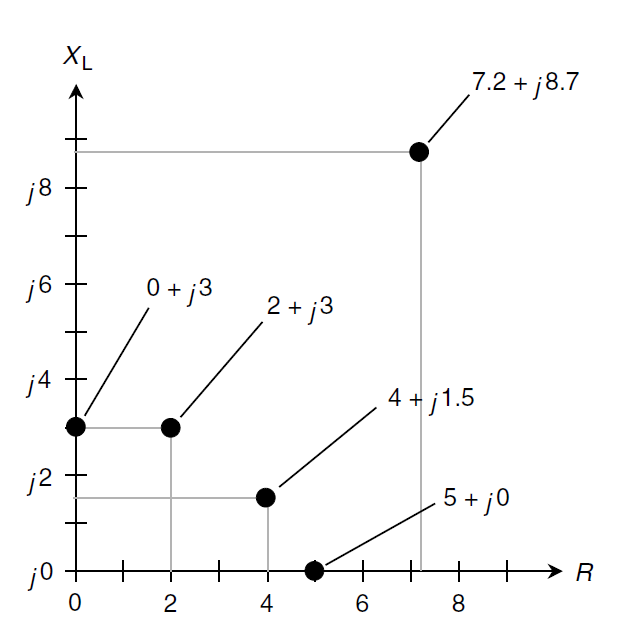
POINTS IN THE RL QUARTER-PLANE
 المؤلف:
S. Gibilisco
المؤلف:
S. Gibilisco
 المصدر:
Physics Demystified
المصدر:
Physics Demystified
 الجزء والصفحة:
377
الجزء والصفحة:
377
 14-10-2020
14-10-2020
 1555
1555
POINTS IN THE RL QUARTER-PLANE
In a circuit containing both resistance and inductance, the characteristics become two-dimensional. You can orient the resistance and reactance halflines perpendicular to each other to make a quarter-plane coordinate system, as shown in Fig. 1. Resistance is shown on the horizontal axis, and inductive reactance is plotted vertically, going upward. Each point on the RL quarter-plane corresponds to a unique complexnumber impedance. Conversely, each complex-number impedance value corresponds to a unique point on the quarter-plane. Impedances on the RL quarter-plane are written in the form R + jXL, where R is the resistance in ohms, XL is the inductive reactance in ohms, and j is the unit imaginary number, that is, the positive square root of -1. The value j in this application is known as the j operator.
Suppose that you have a pure resistance, say, R = 5 ohms. Then the complex-number impedance is 5+ j0 and is at the point (5, 0) on the RL quarter-plane. If you have a pure inductive reactance, such as XL = 3 ohms, then the complex-number impedance is 0+ j3 and is at the point (0, 3) on the RL quarter-plane. These points, and a few others, are shown in Fig. 1.

Fig. 1. The RL impedance quarter-plane showing five points for specific complex-number impedances.
In the real world, all coil inductors have some resistance because no wire is a perfect conductor. All resistors have at least a tiny bit of inductive reactance because they have wire leads at each end and they have a measurable physical length. There is no such thing as a mathematically perfect pure resistance like 5+ j0 or a mathematically perfect pure reactance like 0 +j3. Sometimes you can get close to such ideals, but absolutely pure resistances or reactances never exist (except occasionally in quiz and test problems, of course!).
In electronic circuits, resistance and inductive reactance are sometimes both incorporated deliberately. Then you get impedances values such as 2+ j3 or 4+ j1.5.
Remember that the values for XL are reactances (expressed in ohms) and not inductances (which are expressed in henrys). Reactances vary with the frequency in an RL circuit. Changing the frequency has the effect of making the points move in the RL quarter-plane. They move vertically, going upward as the ac frequency increases and downward as the ac frequency decreases. If the ac frequency goes down to zero, thereby resulting in dc, the inductive reactance vanishes. Then XL = 0, and the point is along the resistance axis of the RL quarter-plane.
 الاكثر قراءة في الكهرومغناطيسية
الاكثر قراءة في الكهرومغناطيسية
 اخر الاخبار
اخر الاخبار
اخبار العتبة العباسية المقدسة


